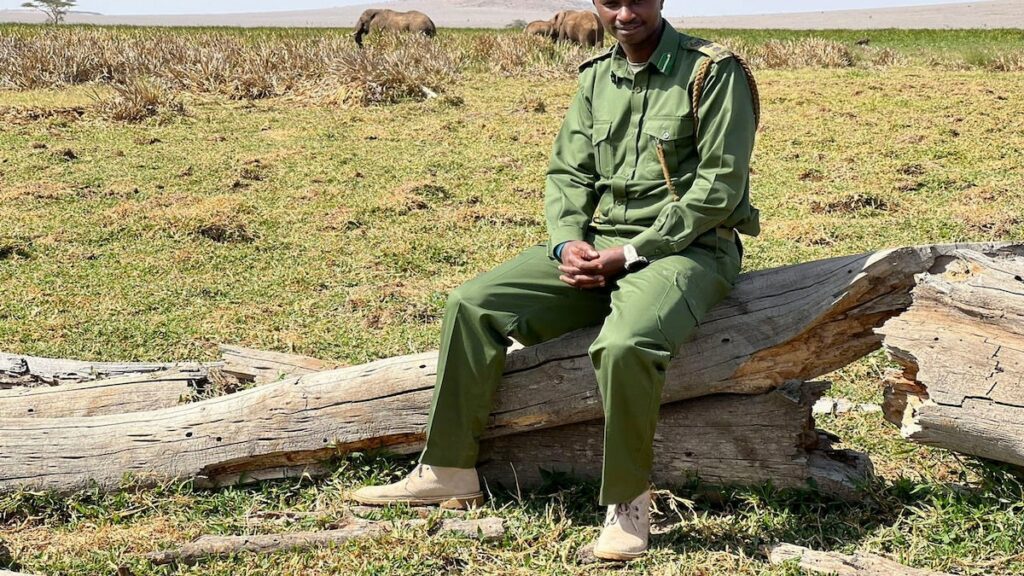This article was produced by National Geographic Traveller (UK).
When Edward Ndiritu joined Lewa Wildlife Conservancy, central Kenya, as a rhino monitor in 1996, poaching had already reduced the nation’s black rhino population from 20,000 in 1970 to fewer than 300. Driven by a fear that they might disappear completely, Edward worked his way up the ranks to become the head of Lewa’s anti-poaching unit. In 2015, his team’s community-minded approach to conservation won him the first Wildlife Ranger Award from conservation charity Tusk. While a rhino hasn’t been killed by poachers in Lewa since 2020, the threat endures.
What inspired you to become a ranger?
I grew up in a village between Mount Kenya and the Aberdare Range, once a wildlife corridor for migratory elephants and black rhinos. During our daily walks to school, my friends and I watched them slowly vanish from the landscape. We soon came to realise that the disappearances were down to both poaching and the disruptive presence of the community as a whole.
What drives people to poach rhinos?
The demand for rhino horn, worth more than its weight in gold in Asia. My team are not dealing with individuals hunting for bushmeat but a vast and wealthy crime network. Behind the poachers and the middlemen who pay them are the facilitators, who supply the poachers with night-vision goggles and silencers. Why does every rhino poaching link back to someone within the community? Money — giving out information to poachers becomes very tempting. In 2011 and 2012, we had a lot of challenges, in Lewa and all over Africa. I remember losing four rhinos in two weeks. It’s horrible: these animals weigh three tonnes but they’re hunted for their horns alone. The rest is left to decay.
That period was a real wake-up call for the government because it transpired that the people driving the poaching were involved in other activities, too, like human trafficking. In 2016, we found a guy in possession of illegal trophies — elephant tusks. A while later, someone was discovered transporting Ethiopians through Kenya to Europe. And then there was another case of someone recruiting school kids to fight for the Al-Shabaab militant group. It was all the same guy.
How has the challenge changed since then?
When I first joined Lewa, people would come into the park, camp out overnight and then spend the day poaching. Now, they’ve upskilled: they have networks and gather intelligence from the local community, so they know where to poach without being spotted by a ranger. Then there’s the technological aspect. In the past, none of these guys had phones — nowadays they have phones and motorbikes.
How have your units adapted?
We’re using cameras, sensors, trackers and gathering lots of information using our Domain Awareness System, which tells us when and where a poaching might occur. We also work much more closely with the community, now our first line of defence. For years, a lack of tangible benefits meant local people saw no value in conservation; today Lewa provides agricultural training, medical facilities, and business support for rural women, which means locals are more likely to report a poaching before it happens.
What kind of skills do you need to be good ranger?
You need be honest and hardy — wild animals don’t have weekends. But you also need to be motivated: a happy ranger is a good ranger, and that’s why we’ve invested in proper training, proper equipment, and made sure they have time to see their families. Today, my job is to ensure their happiness and wellbeing, but when I was first promoted, nobody understood that ensuring the rangers’ wellbeing was the first step to minimising poaching. Conservation is all about people.
Do you feel hopeful about the future of wildlife conservation in Lewa?
I feel good, and I see hope. In conservation, our biggest challenge is funding, because protecting wildlife is very expensive. Thankfully, we have organisations like Tusk, which are helping with fundraising, while Lewa is expanding its network and finding other people who can help support our community projects. In truth, looking after the wildlife within the conservancy is not enough: you have to think about the people outside the fence. Only when those communities are able to live harmoniously with the animals they see everyday will there be a future for wildlife here.
Published in the Jul/Aug 2024 issue of National Geographic Traveller (UK).
To subscribe to National Geographic Traveller (UK) magazine click here. (Available in select countries only).
>>> Read full article>>>
Copyright for syndicated content belongs to the linked Source : National Geographic – https://www.nationalgeographic.com/travel/article/illegal-animal-poaching-kenya
